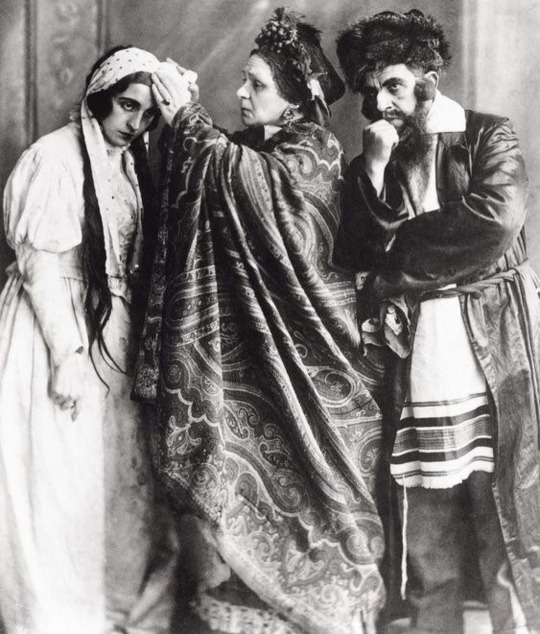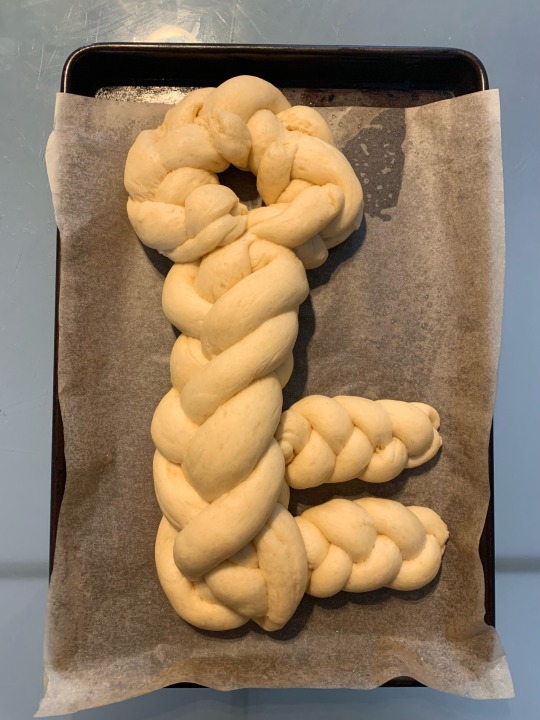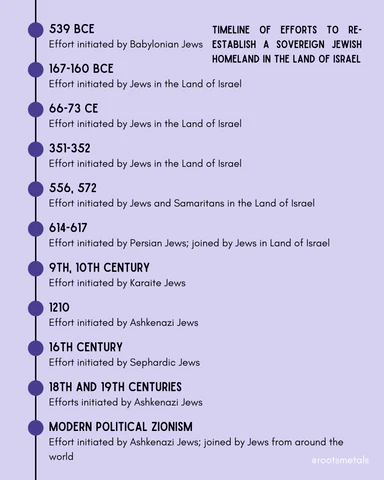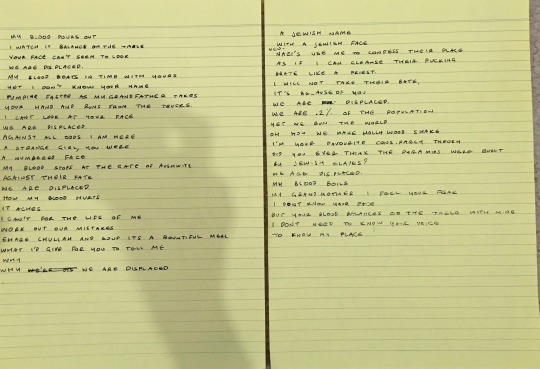#Ashkenazim
Explore tagged Tumblr posts
Text

Scene from the most famous Yiddish play The Dybbuk by the Vilner Trupe. 1910s.
#jumblr#jewish#jews#nesyapost#jewish history#jewish culture#yiddish#Poland#Eastern Europe#jewish art#Jewish theater#Jewish actors#the dybbuk#1910s#yiddish folklore#Jewish folklore#ashkenazim#ashkenazi#photography#vintage photography
946 notes
·
View notes
Text
#jewish#jumblr#chana talks#judaism#am yisrael chai#israel#jewish polls#food poll#fun polls#poll#tumblr polls#random polls#my polls#polls#ashkenazi food#ashkenazim
247 notes
·
View notes
Text
I understand and agree with pointing out that the Holocaust didn’t just affect the Jews that lived in Europe, and shedding light on the stories of Jews in other territories under Axis control. Every life lost or uprooted in the Holocaust matters and deserves to be remembered, not just Ashkenazim.
However, I’ve been seeing a bit of an overcorrection to the point that this valid & important point get twisted by some into the idea that Ashkenazim weren’t actually all that affected by the Holocaust at all and may have actually been safer than other Jews due to being White/European*, and I wanted to walk through exactly why that is so far from the reality and gets into really dangerous Holocaust Distortion.
The fact is that the vast majority of Holocaust victims were Ashkenazim. How do we know this? Well, first and most obvious without even getting into the numbers: the Nazis were most active in Eastern Europe, where most Jews were overwhelmingly Ashkenazi. Germany had colonies elsewhere and the affect the Holocaust had on Jews living in Africa and Asia is not any less important (and the fact remains that their stories are a genuine gap in Holocaust education that needs to be filled), but this doesn’t change the fact that the center of Nazi activity was Europe, and thus that is where their impact on Jews was most intense. But it’s important to not just go off of what seems “obvious” because what’s obvious to any given person is subjective and subject to bias. So let’s look at the numbers:
Estimates prior to the Holocaust put Ashkenazim at 92% of the world’s Jewish population (or roughly 14 million of the 15.3 million total Jewish population), meaning that it would be physically impossible for less than 4.7 million (or 78%) of the 6 million Jews murdered in the Holocaust to be Ashkenazim.

Even that number is only possible to reach by assuming that only Ashkenazism survived and literally every non-Ashkenazi Jew died in the Holocaust, which we categorically know is not the case due to the continued existence of Sephardim & Mizrahim, as well as other Jews. So the number has to be higher than 78%.
Additionally, the fact that the proportion of the world’s Jewish population that was Ashkenazi fell so drastically during to the Holocaust and still hasn’t recovered (from 92% in 1930, only recovering to close to 75% in the last couple decades) means that not only a higher overall number of deaths were Ashkenazim, but that a higher proportion of the total Ashkenazi population died than from other groups.
We also know that 85% of Jews killed in the Holocaust were Yiddish-speakers. The fact that Yiddish is endemic to Ashkenazi culture (and not all Ashkenazim would have even been Yiddish-speakers) due to assimilation means that at least—and most likely more than—85% of Jews killed in the Holocaust were Ashkenazi.
So, no, Ashkenazim were not some privileged subcategory of Jews who avoided the worst of the Holocaust. They were the group most directly devastated by it.
That doesn’t change the fact that the devastation the Nazis and their allies wreaked on other Jews is every bit as important to acknowledge and discuss, and must not fall by the wayside. The stories and experiences of all victims & survivors deserve to be heard, remembered, and honored, not just the most common or most statistically representative of the majority of victims. However, we can (and must) do that without allowing the facts of the Holocaust to be distorted or suggesting Ashkenazim were somehow less affected by the Holocaust or more privileged under the Nazis. The Nazis hated all Jews. Antisemitism affects all Jews. Period.
*without getting too deep into how categories like Ashkanzi/Sephardi/etc. don’t map neatly onto race like so many people seem to want them to. that’s a different post, but just pointing that out
237 notes
·
View notes
Text
Schlissel challah 🗝





Baking challah in the shape of a key (schlissel meaning key in Yiddish) is an Ashkenazi tradition the Shabbat after Pesach, and is said to represent the key to the promised land. I’m usually team poppyseed but sesame seeds are traditional for schlissel challah, because they are supposed to resemble the manna we ate in the desert.
I couldn’t find a technique I liked so I just made one up- I did a 5-strand braid for the stem, and a standard 3-strand for the teeth and the head.
Hope everybody had a wonderful chag!
#challah#jewish food#schlissel challah#shlissel challah#passover#pesach#פסח#פסח 5783#peysakh#pesah#jumblr#jewblr#ashkenazim#ashkenazi#pesach 5783#Passover 5783#pesach 2023#Passover 2023#judaism#queer judaism#kosher food#kosher
461 notes
·
View notes
Text
Taking Intro to Judaism is wild when you're converting to a Sephardic community.
We've had two classes in a row about kashrut. The Rabbi is Ashkenazi. He is also trying to teach us all the of the rules so we'll do fine before the biet din. So he's going down the list of stuff like "Probably no turkey, definitely no Fanta Naranja, no food from restaurants that aren't kashrut, milk and meat plates", etc. And again, I get it. He doesn't expect us to follow all of these rules all at once, we're just being educated.
But one thing I'm finding about Spanish Sephardim is that it's an even harder-core kind of diaspora. There's a broad tolerance for, or lack of observance of, food-related rules that I find fascinating.
Kitniyot are something we're expected to know about, but around here, you can have beans and rice during Pesach. During kabbalat shabbat, we were complaining about how it's impossible--not tricky, impossible--to get Passover wine while drinking plain old normal red wine the day after the Rabbi laid down all the rules about handling grapes.
The Rabbi was like "here look I carry a card with all the banned substances listed on it so when I shop I won't buy something with an insect- or blood-based preservative". Which is cool! But meanwhile, the cantor was like "holy shit, bro, how are you and your wife avoiding eating pork and shellfish IN SOUTHERN SPAIN, you are very serious about being Jews aren't you".
It just seems very Spanish to me (affectionate) to learn the rules and then shrug in their general direction because whatyagonnado?
Anyhow, I howled in agony over Fanta Naranja, but I think giving it up would be best anyway. Probably keeping turkey on the menu, though.
#jumblr#jewish conversion#jew by choice#jew in progress#kashrut#jewish#sephardim#ashkenazim#not intended to be an all inclusive or academic statement#is-the-fire-real original
35 notes
·
View notes
Text
Me 🤝 Ashkenazim
"Fuck pronouncing the letter T specifically"
#jumblr#meme#personal thoughts tag#in my english accent i barely (if ever) pronounce the letter T#there are very specific rules to my accent in general where it's more common to pronounce the T#i have adopted certain aske spellings/accents for certain words if it's more efficient#saying shabbos is SO fun and it's so efficient. i LOVE it#ashkenazi#ashkenazim
16 notes
·
View notes
Text
Ashkenazim became familiar in the West after the great waves of Jewish immigration from Russia and Eastern Europe at the turn of the twentieth century; had it remained at that, they might have gone down in history as a remarkable and interesting community with a rich culture to add to the wealth of human experience, but nothing more. As it was, political Zionism intervened with a definition of Jewish nationhood that was in reality nothing other than the ethnic Ashkenazi identity grafted onto the rest. In other words, the East European Ashkenazim reinterpreted themselves as the pan-Jewish nation, an imagined community with a fabricated unifying narrative. (Israel’s national anthem, it may be noted, was nothing other than a medley of nostalgic Russian tunes.) It was for that reason that generations of non-Ashkenazi Jews who were brought to populate the new Jewish state after 1948 were subjected to what one might call ‘Ashkenazification’, an acculturation process to make them more like ‘real’ or European Jews. But the most egregious aspect of this false Ashkenazi representation of ‘the Jewish people’ was the claim it then made for a primordial connection with Palestine.
Ghada Karmi, One State: The Only Democratic Future for Palestine-Israel
41 notes
·
View notes
Note
I'm a convert trying to figure out how to go about finding my Hebrew name - and I was wondering about the decorum for that? Things I should avoid? How do you know how to choose between the different types of names (like Ashkenazi, Sephardic, Mizrahi, etc, languages or just Hebrew?)? Say example, I have Spanish ancestry, should I take a Ladino name? Or if my synagogue is Ashkenazi should I take a Yiddish name? Should I just stick with Hebrew? I have no idea and I am so confused lol
Since anon didn't state a FOR, and I've seen many variations between FORs, please state yours when commenting so that it's clear for everyone.
#jumblr#ask jumblr#judaism#frumblr#jewblr#jewish#jewish conversion#hebrew name#hebrew#yiddish#ladino#ashkenazi#sephardic#sephardim#ashkenazim#jewish convert#conversion to judaism
17 notes
·
View notes
Text


Yehudit Shadur (יהודית שדור, Israeli, 1928 - 2011).
[...] has been widely recognized as the foremost exponent in reviving the centuries-old, almost forgotten, Jewish folk art form of papercutting. Her vigorous compositions draw upon traditional Jewish themes and symbols, including passages from the Psalms and prophetic books of the Bible. Her work is a synthesis of venerable religious forms and contemporary perceptions rendered in a universally appealing artistic language. x
#Yehudit shadur#jewish artists#israeli artists#hebrew art#jewish art#israeli art#jewish papercutting#papercut#ashkenazim#אשכנזים#יהודית שדור
6 notes
·
View notes
Text

#jumblr#jewish#jews#nesyapost#jewish history#judaism#jewish culture#yiddish#Christmas#linguistics#i love you yiddish speakers so much#i asked my hassidic friend and he confirmed lol#language#ashkenazim
121 notes
·
View notes
Text
The werewolf is a sorcerer, or a demon which inhabits the earth in man’s form, but which at will assumes the shape of a wolf and attacks and consumes men. Like his feminine counterpart, the estrie, he requires human blood in his diet—another version of the vampire.
Joshua Trachtenberg, Jewish Magic and Superstition: A Study in Folk Religion; The Powers of Evil: “Foreign” Demons
#jewish magic and superstition#joshua trachtenberg#jewish magic and superstition: a study in folk religion#the powers of evil#‘foreign’ demons#werewolf#werewolves#vampire#vampires#ashkenazim#cultural cross pollination
13 notes
·
View notes
Text

Timeline Of Efforts To Re-Establish A Sovereign Jewish Homeland In The Land Of Israel
credit to rootsmetals
written description under the cut
Infographic vertically detailing efforts to re-establish a sovereign jewish homeland in the land of israel, and which jewish communities initiated said efforts.
539 BCE - Effort initiated by Babylonian Jews
167-160 BCE - Effort initiated by Jews in the Land Of Israel
66-73 CE - Effort initiated by Jews in the Land Of Israel
351-352 CE - Effort initiated by Jews in the Land Of Israel
556, 572 CE - Effort initiated by Jews and Samaritans in the Land Of Israel
614-617 CE - Effort initiated by Persian Jews, joined by Jews in the Land Of Israel
9th, 10th Century CE - Effort initiated by Karaite Jews
1210 CE - Effort initiated by Ashkenazi Jews
16th Century CE - Effort initiated by Sephardi Jews
18th & 19th Centuries - Effort initiated by Ashkenazi Jews
Modern Political Zionism - Effort initiated by Ashkenazi Jews; joined by Jews from around the world
#jewish#jumblr#chana talks#judaism#israel#am yisrael chai#zionism#arab colonialism#mizrahim#mizrahi jews#sephardim#sephardi jews#ashkenazim#ashkenazi jews
62 notes
·
View notes
Text
27 notes
·
View notes
Text

My poem about Jewishness
#poem#Jewish#jumblr#ashkenazim#ashkenazi jewish#ashkenazi jew n queer#Jew#Jew and queer#queer jew#Jewish art#Jewish poem#actually jewish#queer poem#queer art#jewish zine#trans jew#writing#story#punk#queer#writer#non binary
22 notes
·
View notes
Text
🌿☘️🍃
#car made of hemp#strong#unbreakable car#green car#hemp 10X stronger than steel#dirty politics#corruption#greed#power#destruction#deep state#oligarchs#ashkenazim#zionists#Rothschilds#Rockefellers#Khazarians#crimes against humanity#these people are evil#speaktruth#fight for justice#standup#speak up#truth#please share#wwg1wga
13 notes
·
View notes
Text
(the answer is no. Elhaik is a joke)
#ashkenazi jews#ashkenazi#ashkenazim#eran elhaik#pseudogenetics#genetics#propaganda#quora#good quora answers
10 notes
·
View notes